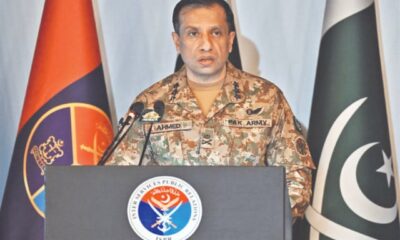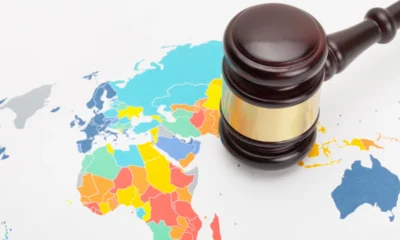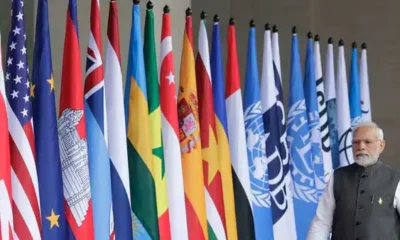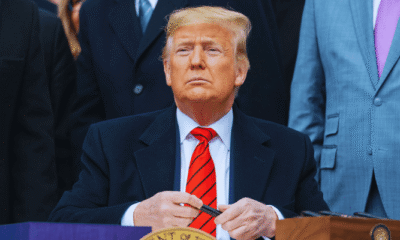World News
Who is running in Canada’s federal election?

Prime Minister and Liberal leader Mark Carney has called an election in Canada, kickstarting five weeks of campaigning before Canadians head to the polls.
Voting day will officially be on Monday 28 April.
It will be the first election in a decade without former Prime Minister Justin Trudeau on the ballot, and the two major parties in Canada – the Conservatives and the Liberals – are neck-and-neck in the polls, making it a race to watch.
While Canadians don’t vote for prime minister directly, the leader of the party that wins the most seats will become head of the country.
Here is a breakdown of the leaders of Canada’s major parties.
Liberal Party leader Mark Carney

Carney, 59, is the incumbent prime minister of Canada, but he has only been on the job for a few days.
His party overwhelmingly chose him – with more than 80% of the vote – to succeed Justin Trudeau as Liberal leader earlier this month. He became prime minister shortly after, following Trudeau’s resignation.
For many in Canada and the UK, Carney is a familiar face. He was head of both the Banks of Canada and England, serving at the former during the 2008 financial crash and the latter during Brexit.
He was born in Fort Smith, Northwest Territories, making him the first Canadian prime minister from the north. Carney later grew up in Edmonton, Alberta, before he attended Harvard University and then Oxford, where he studied economics.
Carney is hailed for his financial expertise. He has also taken a defiant stance against US President Donald Trump, vowing retaliation against his tariffs and stating that Canada will never become the 51st US state.
But Carney is politically untested. He has never been elected to public office in Canada, and this general election will be his very first. His French is also weak, which could be a liability among voters who feel strongly about preserving Canada’s French-speaking heritage, especially in the province of Quebec.
Recent polls show his party is slightly trailing behind the Conservatives, but more Canadians say they think Carney would be a better prime minister than his opponent Pierre Poilievre.
Conservative leader Pierre Poilievre

Poilievre, 45, originally hails from Calgary, Alberta. He has been in Canadian politics for nearly two decades – first elected to the House of Commons at age 25, making him one of the youngest MPs at the time.
Since then, he has consistently advocated for a low-tax, small government in Canada.
He is known for his confrontational style of politics. In recent years, Poilievre has tirelessly attacked the Liberals and Trudeau, saying that their “disastrous” and “woke” policies have worsened the quality of life in Canada, while promising a return to “common sense politics” if his party were to form government.
It is a message that has resonated with many Canadians who have been worried about the country’s housing crisis, stagnant wages and high cost of living. Poilievre has led in national polls since mid-2023, and analysts had projected a near-certain win for his party in the upcoming election.
But the Liberal Party has since caught up to him in the polls, following Trudeau’s resignation and the rise of Carney as Liberal leader.
Poilievre has been criticised for his populist style of politics and has drawn comparisons to Trump at a time when Canadians have rejected the US President’s tariffs and his rhetoric that Canada should become the “51st state”.
Poilievre has sought to shift his messaging since, distancing himself from Trump and vowing to put “Canada first.”
Trump himself has said that Poilievre is not “MAGA enough”, though the Conservative leader has been praised by Trump ally and tech titan Elon Musk.
Bloc Québécois leader Yves-François Blanchet

The Bloc Québécois is a Quebec nationalist party that only runs candidates in the French-speaking province, meaning its leader is unlikely to become Canada’s next prime minister.
Still, they are a key player in Canadian elections, and their popularity in Quebec could determine the fate of the other major parties looking to form government.
Blanchet has led the party since 2019. He is known for his frankness, calling Trump’s 51st state rhetoric nonsense.
“It’s enough jibber-jabber,” Blanchet said during an address on Trump’s tariffs earlier this month in Montreal. “We can say whatever we want, but that doesn’t mean we can do whatever we want.”
He has also dismissed Trump’s tariffs, saying: “I’m sure there will be somebody on his plane between a basketball game and a baseball game to tell him, don’t do that, because it’s bad for us. I’m sure that at the end of the day, the voice of reason will prevail.”
On domestic issues, Blanchet has pushed for Quebec to diversify its trade partners, and has asked for a prominent seat at Canada’s economic planning table, noting that his province is home to the largest aluminium sector in the country – a commodity that has been targeted by US tariffs.
Blanchet has also suggested that the appetite for an independent Quebec will “come roaring back” when and if the US-Canada relationship stabilises.
Polling shows the Bloc – who are going into the election with 33 seats in Parliament – have been trailing behind the Liberal Party in Quebec.
New Democratic Party leader Jagmeet Singh

Singh, 46, is leader of the NDP, a left-leaning party that traditionally focuses on worker and labour issues. He made history in 2017 when he became the first ethnic minority and practising Sikh to lead a major political party in Canada.
In 2019, the former criminal defence lawyer was elected as an MP in a British Columbia riding, where he has served in public office since.
The NDP had helped the Trudeau Liberal government keep its hold on power since 2021, providing needed votes in Parliament in exchange for support on progressive legislation like dental benefits for lower-income families and a national pharmacare programme covering birth control and insulin.
But in late 2024, Singh tore up that “supply and confidence” agreement, after Trudeau’s cabinet directed its industrial relations board to impose binding arbitration to end a work stoppage at Canada’s two largest railways.
At the time, Singh had said that the Liberals “let people down” and didn’t “deserve another chance from Canadians”.
But his party has struggled to shore up support. Polls show that only 9% of Canadians intend to vote for them as of mid-March, with their ground shrinking while support for the Liberals has risen.
A big question will be whether the NDP will be able to grow the number of seats they occupy in the House of Commons and maintain official party status.
In the early 2010s, the party had enough support to form the official opposition, meaning it was the party with the second-most seats in Parliament. By 2021, their seat number had shrunk to 24 out of 338.
Taken From BBC News
World News
Titanic passenger’s watch expected to fetch £1m

A gold pocket watch recovered from the body of one of the richest passengers on the Titanic is expected to fetch £1m at auction.
Isidor Straus and his wife Ida were among the more than 1,500 people who died when the vessel travelling from Southampton to New York sank after hitting an iceberg on 14 April 1912.
His body was recovered from the Atlantic days after the disaster and among his possessions was an 18 carat gold Jules Jurgensen pocket watch that will go under the hammer on 22 November.
Auctioneer Andrew Aldridge, of Henry Aldridge & Son in Wiltshire, told BBC Radio Wiltshire: “With the watch, we are retelling Isidor’s story. It’s a phenomenal piece of memorabilia.”
Mr Straus was a Bavarian-born American businessman, politician, and co-owner of Macy’s department store in New York.
“They were a very famous New York couple,” said Mr Aldridge.
“Everyone would know them from the end of James Cameron’s Titanic movie, when there is an elderly couple hugging as the ship is sinking – that’s Isidor and Ida.”
On the night of the sinking, it is believed his devoted wife refused a place in a lifeboat as she did not want to leave her husband and said she would rather die by his side.
Ida’s body was never found.
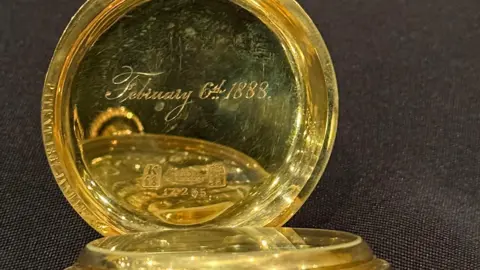
The pocket watch stopped at 02:20, the moment the Titanic disappeared beneath the waves.
It is believed to have been a gift from Ida to her husband in 1888 and is engraved with Straus’ initials.
It was returned to his family and was passed down through generations before Kenneth Hollister Straus, Isidor’s great-grandson, had the movement repaired and restored.
It will be sold alongside a rare letter Ida wrote aboard the liner describing its luxury.
She wrote: “What a ship! So huge and so magnificently appointed. Our rooms are furnished in the best of taste and most luxurious.”
The letter is postmarked “TransAtlantic 7” meaning it was franked on board in the Titanic’s post office before being taken off with other mail at Queenstown, Ireland.
Both items will be offered by Henry Aldridge & Son in Wiltshire, with the letter estimated to fetch £150,000.
The watch is set to become one of the most expensive Titanic artefacts ever sold.
The auction house said news of the sale had already generated “significant interest from clients all over the world”.
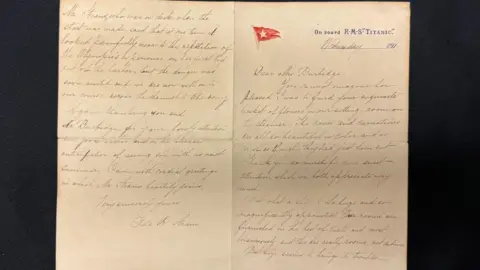
“Theirs was the ultimate love story – Isidor epitomised the American Dream, rising from humble immigrant to a titan of the New York establishment, owning Macy’s department store,” a spokesperson for the auction house said.
“As the ship was sinking, despite being offered a seat in a lifeboat, Ida refused to leave her husband and stated to him ‘Isidor we have been together all of these years, where you go, I go’.”
The spokesperson added: “This is the reason why collectors are interested in the Titanic story 113 years later – every man, woman and child had a story to tell and those stories now are retold through these objects.”
A gold pocket watch presented to the captain of the Carpathia, the steamship which rescued more than 700 Titanic survivors, sold last year a record-breaking £1.56m.
World News
Major corruption scandal engulfs top Zelensky allies

Ukraine’s energy and justice ministers have resigned in the wake of a major investigation into corruption in the country’s energy sector.
President Volodymyr Zelensky called for Energy Minister Svitlana Grynchuk and Justice Minister Herman Halushchenko’s removal on Wednesday.
On Monday anti-corruption bodies accused several people of orchestrating a embezzlement scheme in the energy sector worth about $100m (£76m), including at the national nuclear operator Enerhoatom.
Some of those implicated in the scandal are – or have been – close associates of Zelensky’s.
The allegation is that Justice Minister Herman Halushchenko and other key ministers and officials received payments from contractors building fortifications against Russian attacks on energy infrastructure.
Among those alleged to be involved are former Deputy Prime Minister Oleksiy Chernyshov and Timur Mindich – a businessman and a co-owner of Zelensky’s former TV studio Kvartal95. He has since reportedly fled the country.
Halushchenko said he would defend himself against the accusations, while Grynchuk said on social media: “Within the scope of my professional activities there were no violations of the law.”
The National Anti-Corruption Bureau of Ukraine (Nabu) and Specialised Anti-Corruption Prosecutor’s Office (Sap) said the investigation – which was 15 months in the making and involved 1,000 hours of audio recordings – uncovered the participation of several members of the Ukrainian government.
According to Nabu, the people involved systematically collected kickbacks from Enerhoatom contractors worth between 10% and 15% of contract values.
The anti-corruption bodies also said the huge sums had been laundered in the scheme and published photographs of bags full of cash. The funds were then transferred outside Ukraine, including to Russia, Nabu said.
Prosecutors alleged that the scheme’s proceeds were laundered through an office in Kyiv linked to the family of former Ukrainian lawmaker and current Russian senator Andriy Derkach.
Nabu has been releasing new snippets of its investigation and wiretaps every day and on Tuesday it promised more would come.
The scandal is unfolding against the backdrop of escalating Russian attacks on Ukrainian energy facilities, including substations that supply electricity to nuclear power plants.
It will also shine a spotlight on corruption in Ukraine, which continues to be endemic despite work by Nabu and Sap in the 10 years since they were created.
In July, nationwide protests broke out over changes curbing the independence of Nabu and Sap. Ukrainians feared the nation could lose the coveted status of EU candidate country which it was granted on condition it mounted a credible fight against corruption.
Kyiv’s European partners also expressed severe alarm at the decision, with ambassadors from the G7 group of nations expressing the desire to discuss the issue with the Ukrainian leadership.
The backlash was the most severe to hit the Ukrainian government since the start of Russia’s full-scale invasion in 2022 and was only quelled by Zelensky’s decision to reinstate the freedom of the two anti-corruption bodies.
Yet for some that crisis brought into question Zelensky’s dedication to anti-corruption reforms. The latest scandal threatens to lead to more awkward questions for the Ukrainian president.
World News
Italy investigates claim that tourists paid to go to Bosnia to kill besieged civilians
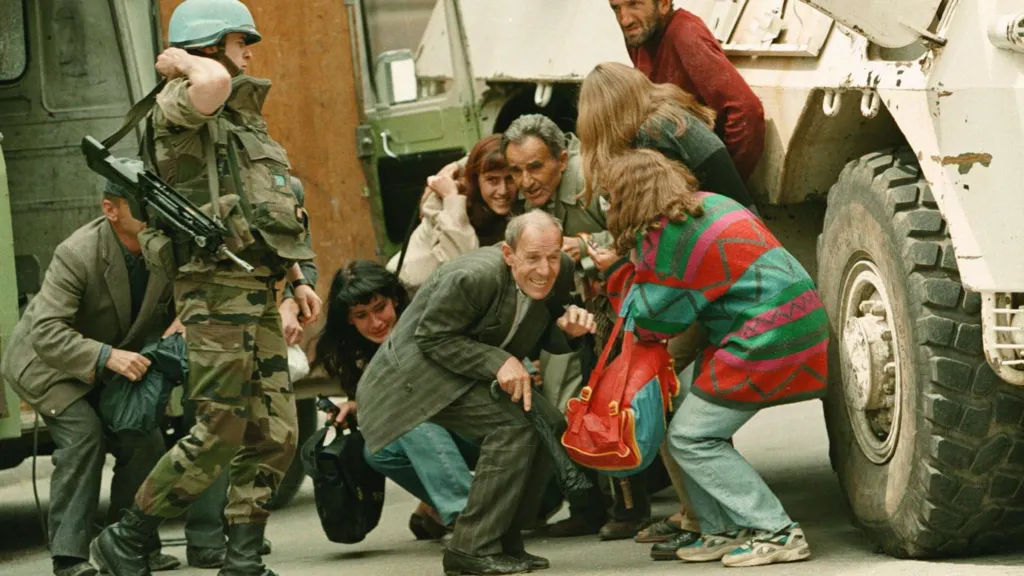
The public prosecutor’s office in Milan has opened an investigation into claims that Italian citizens travelled to Bosnia-Herzegovina on “sniper safaris” during the war in the early 1990s.
Italians and others are alleged to have paid large sums to shoot at civilians in the besieged city of Sarajevo.
The Milan complaint was filed by journalist and novelist Ezio Gavazzeni, who describes a “manhunt” by “very wealthy people” with a passion for weapons who “paid to be able to kill defenceless civilians” from Serb positions in the hills around Sarajevo.
Different rates were charged to kill men, women or children, according to some reports.
More than 11,000 people died during the brutal four-year siege of Sarejevo.
Yugoslavia was torn apart by war and the city was surrounded by Serb forces and subjected to constant shelling and sniper fire.
Similar allegations about “human hunters” from abroad have been made several times over the years, but the evidence gathered by Gavazzeni, which includes the testimony of a Bosnian military intelligence officer, is now being examined by Italian counter terrorism prosecutor Alessandro Gobbis.
The charge is murder.
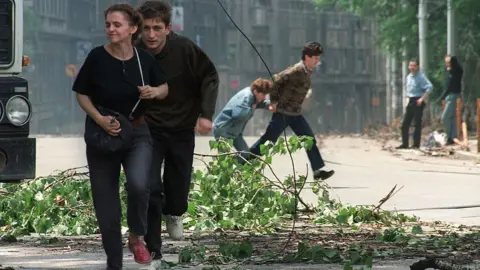
The Bosnian officer apparently revealed that his Bosnian colleagues found out about the so-called safaris in late 1993 and then passed on the information to Italy’s Sismi military intelligence in early 1994.
The response from Sismi came a couple of months later, he said. They found out that “safari” tourists would fly from the northern Italian border city of Trieste and then travel to the hills above Sarajevo.
“We’ve put a stop to it and there won’t be any more safaris,” the officer was told, according to Ansa news agency. Within two to three months the trips had stopped.
Ezio Gavazzeni, who usually writes about terrorism and the mafia, first read about the sniper tours to Sarajevo three decades ago when Italian newspaper Corriere della Sera reported the story, but without firm evidence.
He returned to the topic after seeing “Sarajevo Safari”, a documentary film from 2022 by Slovenian director Miran Zupanic which alleges that those involved in the killings came from several countries, including the US and Russia as well as Italy.
Gavazzeni began to dig further and in February handed prosecutors his findings, said to amount to a 17-page file including a report by former Sarajevo mayor Benjamina Karic.
-

 Europe News9 months ago
Europe News9 months agoChaos and unproven theories surround Tates’ release from Romania
-

 American News9 months ago
American News9 months agoTrump Expels Zelensky from the White House
-

 American News9 months ago
American News9 months agoTrump expands exemptions from Canada and Mexico tariffs
-

 American News9 months ago
American News9 months agoZelensky bruised but upbeat after diplomatic whirlwind
-

 Art & Culture9 months ago
Art & Culture9 months agoThe Indian film showing the bride’s ‘humiliation’ in arranged marriage
-

 Art & Culture9 months ago
Art & Culture9 months agoInternational Agriculture Exhibition held in Paris
-

 Pakistan News5 months ago
Pakistan News5 months agoComprehensive Analysis Report-The Faranian National Conference on Maritime Affairs-By Kashif Firaz Ahmed
-

 Politics9 months ago
Politics9 months agoUS cuts send South Africa’s HIV treatment ‘off a cliff’


